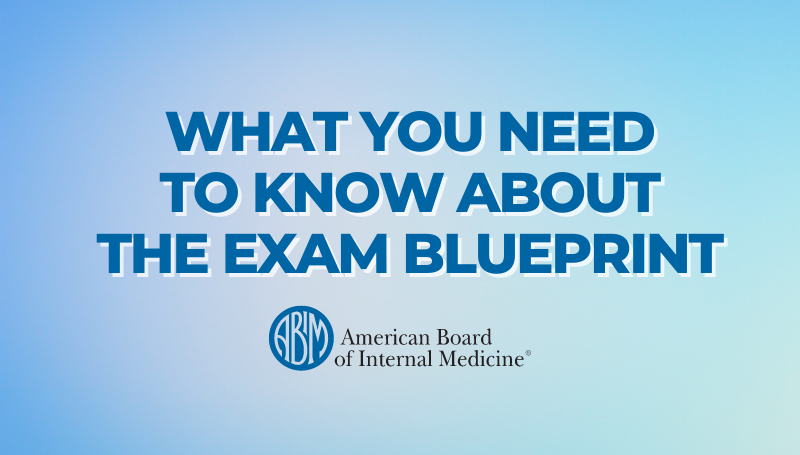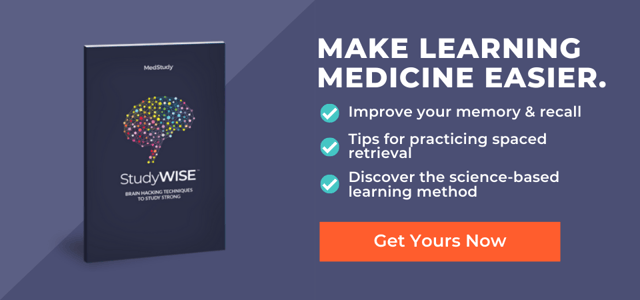The ABIM Blueprint for Internal Medicine Boards

Key points:
- The ABIM blueprint shows the topics for each exam. The blueprint shows an outline of the content areas and their approximate percentages for a typical exam
- Use the ABIM blueprint to understand the content you need to review before your exam, as it also shows what percent of exam questions will be about each topic
- ABIM exam questions describe patient scenarios and ask about the tasks performed by physicians in the course of practice
While we’ll never know exactly the questions that’ll be on the ABIM Certification Exam, we can look to the ABIM blueprint to discover the topics that they’ll test you on, as well as the percentage weight of each topic in the exam.
What is the ABIM blueprint?
The ABIM blueprint shows the topics for each exam. The blueprint shows an outline of the content areas and their approximate percentages for a typical exam.
The certification exam is designed to evaluate whether you possess the knowledge, diagnostic reasoning, and clinical judgment skills expected of a certified Internist.
The ABIM blueprint for internal medicine
Content for the ABIM exam is outlined in the ABIM blueprint, which is reviewed annually. You will use the ABIM blueprint to understand the content you need to review before your exam, as it also shows what percent of exam questions will be about each topic.
- Allergy and Immunology 2%
- Cardiovascular Disease 14%
- Dermatology 3%
- Endocrinology, Diabetes, and Metabolism 9%
- Gastroenterology 9%
- Hematology 6%
- Infectious Disease 9%
- Miscellaneous 2%
- Nephrology and Urology 6%
- Neurology 4%
- Obstetrics and Gynecology 3%
- Medical Oncology 6%
- Ophthalmology 1%
- Otolaryngology and Dental Medicine 1%
- Psychiatry 4%
- Pulmonary Disease 9%
- Rheumatology and Orthopedics 9%
- Geriatric Syndromes 3%
Total 100%
Exam questions in those content areas may also include topics in Critical Care Medicine, Prevention, Clinical Epidemiology, Ethics, Nutrition, Palliative and End-of-Life Care, Adolescent Medicine, Occupational Medicine, Patient Safety and Substance Abuse.
ABIM exam format
The ABIM board exam is a proctored exam that takes about 10 hours to complete. It’s composed of up to 240 single-best-answer multiple-choice questions.
ABIM exam questions describe patient scenarios and ask about the tasks performed by physicians in the course of practice
- Making a diagnosis
- Ordering and interpreting results of tests
- Recommending treatment or other patient care
- Assessing risk, determining prognosis, and applying principles from epidemiologic studies
- Understanding the underlying pathophysiology of disease and basic science knowledge applicable to patient care
ABIM board exam length
It will take you about 10 hours (including breaks) to complete the entire 240-question ABIM exam.
ABIM total number of questions
There are 240 questions on the ABIM exam. 35 questions are considered ‘new’ and won’t count toward your final score.
Unanswered questions are scored as incorrect, so make sure you answer every question!
Most questions describe clinical scenarios and ask about the work you do during your normal course of practice. Some questions require the interpretation of illustrative materials such as electrocardiograms, radiographs, and photomicrographs (e.g., blood films, Gram stains, urine sediments).
Familiarize yourself with the question format in advance to be more confident going into the exam.
ABIM questions per block
There are 240 questions split into ‘modules,’ or blocks of up to 60 questions.
See the entire ABIM exam blueprint.
The 2023 ABIM blueprint for certification
MedStudy for Internal Medicine is carefully created according to the ABIM blueprint. That means that the content in MedStudy study tools will be reflective of what you’ll see on the exam, with a balance of scenarios that are relevant to primary care and hospital care, including:
- Making a diagnosis
- Ordering and interpreting results of tests
- Recommending treatment or other patient care
- Assessing risk, determining prognosis, and applying principles from epidemiological studies
- Understanding the underlying pathophysiology of disease and basic science knowledge applicable to patient care
Once you’ve reviewed MedStudy, you’ll feel confident walking into your ABIM exam.
Related content:



